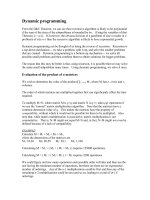Dynamic planet
Bạn đang xem bản rút gọn của tài liệu. Xem và tải ngay bản đầy đủ của tài liệu tại đây (5.78 MB, 61 trang )
‘SIDE VIEW’
100,000 ly
‘TOP VIEW’
Solar System on outside
of Orion Arm
(25,000 light years from centre)
Nebular hypothesis
Important theorists: Emanuel Swedenborg (1734), Immanuel Kant (1755), Pierre-Simon
Laplace (1796), Victor Safronov (1972) – Solar nebular disk model (SNDM)
Evidence: observations systems at varying stages
1. Nebula: Giant Molecular Cloud (GMC) results
from collision(s) or explosion of dying star
3. H and He condense into Sun
4. Disk of matter (many elements) around sun
5. Disk slowly accretes into clumps (planetesimals)
that also contain heavier elements
6. planetesimals → planetoids →
planets and satellites
Hubble Space Telescope
view of a new solar system
1500 l-y away in the Orion
Nebula
Eons, Eras, Periods and Epochs
Superposition: youngest rocks superimposed on
older rocks “Relative time”
Dating by radioactive isotopes
Half-life: time for ½ of unstable isotopes to decay
“Absolute time”
Uniformitarianism:
“The same physical processes active in the
environment today have been operating throughout
geologic time” Hutton (1795), Lyell (1830)
Red ovals
indicate
major
extinction
events:
when
extinction
rate greatly
exceeds
speciation
rate
The Earth in
cross-section
Upper mantle
and lithosphere
ISOSTASY
Elevation of tectonic plates
determined by density/thickness
Mountain masses
displace mantle
material
Isostatic adjustment
due to loss of mass
by erosion
Deformation from
sediment load
Mineral
A natural, inorganic compound
with a specific chemical formula
and a crystalline structure
Examples
silicates (quartz, feldspar, clay minerals),
oxides (eg., hematite)
carbonates (eg., calcite)
An assemblage of minerals bound
together
• Igneous (solidify & crystallize from
molten magma/lava)
• Sedimentary
(settling & cementation)
• Metamorphic
(altered under pressure)
• from magma
(molten rock
beneath the
surface)
• intrusive or
extrusive
(from lava)
Laccolith
Sill
Dike
Batholith
plutons
Existing rock or organic material is
digested by weathering, picked up by
erosion, moved by transportation,
and deposited at river, beach and
ocean sites.
Lithification follows (cementation,
compaction and hardening)
Laid down in horizontally-layered beds
Conglomerate
Sandstone
Siltstone
Shale
Limestone
Coal
largest clasts
sand cemented together
derived from silt
mud/clay compacted into
rock
calcium carbonate, bones
and shells cemented or
precipitated in ocean waters
ancient plant remains
compacted into rock
note the
shells
Any type of rock is transformed,
under pressure and increased
temperature
Harder and resistant to weathering
Produced from any rock type by:
•Compressional forces due to plate collisions
•Regional and contact metamorphism
Shale
Slate
Granite
Gneiss
Basalt
Schist
Limestone, dolomite
Marble
Sandstone
Quartzite
Crustal
Movements









